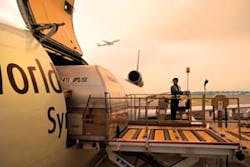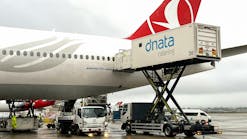Pick a number, any number. Double it, then add or subtract — in fact, do almost anything you like with it, and your answer will represent the number of ground handlers at an airport somewhere in the world. From monopoly suppliers such as Dnata at Dubai international to the double-digit arenas of Amsterdam Schiphol and London Heathrow, it seems regulation and historical circumstances are bigger influences than optimization.
Across the European Union, liberalization regulations have without doubt played the primary role in changing the ground services landscape over the past 14 years. Directive 96/67/EC opened up the ground handling market to competition on a progressive basis. It was a necessary piece of legislation given the way monopoly suppliers held sway at many EU airports at the time. Airlines were complaining vociferously about the toxic combination of high prices and low service levels.
The Directive stipulated that at every EU airport handling in excess of 1 million passengers per annum, or 25,000 metric tons of cargo, there should be no fewer than two providers covering each category of service (baggage handling, ramp handling, fuel and oil handling, freight and mail handling). Moreover, at least one of these suppliers should be entirely independent of the airport or the dominant air carrier at that airport.
Exemptions are available, enabling airports suffering from space or capacity constraints to limit the number of handlers — though this is usually on a temporary basis. Overall, the policy has led to growth in the ground handling market across all service categories, and the European Commission is now considering modifying the Directive to deliver even greater market liberalization.
The magic number
It all begs the question of whether an airport can have too many, or too few, ground support providers. While the EU’s experience seems to indicate that going large generates benefits, Dnata is generally reported to offer a very competitive service and price. Proving that it’s not afraid of a competitive marketplace, Dnata has even pitched into the European market with the takeover of a number of ground handling operations.
And since 2007 Indian legislators have been floating the idea of limiting competition in ground handling. The suggested policy would view the airport operator, the flag carrier Air India, and one other provider as sufficient choice. Not surprisingly, airlines that self handle — particularly privately-owned Indian LCCs Jet Airways and Kingfisher — have campaigned vigorously against limitation, and the policy has been deferred time and again.
But it is not just governments looking to corral the ground handling market. Perhaps understandably, ground handlers themselves are also keen to see what many feel are appropriate limits on service provision. Aside from the obvious issue of self-preservation, there is the legitimate question of operational efficiency, whether within the terminal or on the ramp. “Space is a concern at many airports and that does compromise safety and costs,” agrees Stephan Beerli, spokesman for Swissport.
Ground handlers do themselves no favors, however, as they are not always at an airport as a result of traffic growth or a service request. “It could be strategy, meaning they want a flag on the airport,” Beerli suggests. This makes it hard to argue that the number of ground handlers is driven solely by market requirements. An expansionist company could be simply looking to stake a claim, perhaps as a precursor to bidding for existing suppliers’ clients.
In any case, Beerli believes that limiting numbers does not mean restricted competition. “When there are limits the airlines still have a free choice of the handlers that are present at the airport,” he says.
Airports aligned
Although embracing the competitive ethos, many airport operators concur that the number of ground service providers at any one airport cannot be allowed to grow completely unchecked.
Richard Montague, head of ramp operations at BAA, accepts limitations are unlawful and says London Heathrow can operate very effectively with any number of providers. “Having improved our punctuality at Heathrow over the past two years from 60 percent to over 80 percent while operating a multihandler operation on the busiest airfield in the world with 1,350 movements a day, I would have to say yes, we can operate efficiently with any number of handlers,” he notes.
However, he argues that putting a ceiling on numbers could actually deliver benefits. “Fewer handlers could potentially reduce the higher turnover of handling contracts we have seen in the industry, as handlers compete commercially on very small margins,” he says. “Is there a danger of lack of competition if there are too few handlers? With 12 primary ground handlers at London Heathrow we could probably argue that too few handlers is not something we have any experience of in recent years. However, it would seem the commercial pressure airlines place on handlers would preclude abuse of a lack of competition.”
There are practicalities to consider as well. Ostensibly, airlines have the autonomy to select a ground handling agent. But London Heathrow, like many other gateways, operates a change approvals process covering issues such as new entrants or airlines changing a handler. “There would be a point where the airport infrastructure would not support any more handling agents and we would have to deny the request,” notes Montague. “In practice, we work as hard as possible to support an airline’s choice of handler.”
Athens International Airport works under a number of operational practices and laws. One objective is providing a competitive environment for airport users. But it also wants to promote operational efficiency, particularly in the use of equipment and facilities.
These twin objectives are not necessarily mutually exclusive, but combining them is far from easy. A spokesperson for the Athens International says ground handling operations must be viable. If there are more providers than needed, then it will negatively affect ramp operations and the financial viability of the operators, not to mention the quality level of the services provided.
Although the danger of a lack of competition is acknowledged, Athens has restricted the number of handling companies, believing that the level of traffic cannot justify unchecked growth in provision. The spokesperson says a few operators can still generate some fierce competition.
Way out east
The optimal number of ground handlers is not just a European issue. At Hong Kong International Airport (HKIA), for example, ground services are generally non-exclusive. There are three ramp handlers and three aircraft line maintenance operators at HKIA. In addition, the Airport Authority can introduce additional operators at any time — if there are operational and market demands.
Says a spokesperson for the Airport Authority: “The number of ground handlers providing each service varies with the service nature. To strike a balance between adequate supply of high-quality services and healthy competition, we believe an optimal number of ground handlers at the airport should be maintained.”
Airlines also agree on the need for optimal efficiency but, like any customer, they insist on having a choice. Self-handling may be their preferred option, like the privately owned airlines of India, or they may be an enthusiastic outsourcer. The one imperative, as they struggle for profitability in a volatile market, is low cost.
Air New Zealand reports that supply and demand should dictate the number of ground handlers required at each particular airport, but notes that the airline is not of a sufficient size to ask a preferred supplier to open an operation at a particular destination.
Austrian also chooses from among the existing available options. Its spokesman, Michael Braun, meanwhile states simply that the optimum number of ground handlers at an airport is definitely more than one. “A monopoly situation has definitely to be avoided,” he says. “The ideal number of ground handlers — depending on the size of the airport — is three, maybe four if the airport is big. In reality, we see that usually three ground handling agents are enough to ensure competition.”
The experience of the EU shows that an open market situation can resolve the high-price, low- quality conundrum. But any new entrant must be viable and not unduly compromise the operational efficiency of other airport users.
And what works for Europe is not easily exported into other markets, whether mature or emerging, as the Dnata and Indian situations demonstrate. For the ground handling industry, it seems that whichever way you cut the deck, that magic number will remain an illusion.







